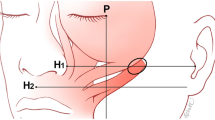Abstract
The independent effect of the contraction of various facial mimetic muscles on the nasolabial fold was defined through study of cadaver dissections. The four major lip elevator muscles were identified and the effect of traction of these muscles on the nasolabial fold was studied. This study identified the levator alae muscle (levator labii superioris alaeque nasi) as the primary facial muscle responsible for creating the medial nasolabial fold. The levator labii superioris muscle was found to define the middle nasolabial fold. These two facial muscles may be significant in the etiology of the prominent nasolabial fold that occurs with aging.
Similar content being viewed by others

References
Freilinger G, et al: Surgical anatomy of the mimic muscle system and the facial nerve: Importance for reconstructive and aesthetic surgery. Plast Reconstr Surg 80:686, 1987
Hamra ST: The deep plane rhytidectomy. Plast Reconstr Surg 86:53, 1990
Kaye BL: Facial Rejuvenative Surgery. Philadelphia: J.B. Lippincott, 1987, p 104
Keele KD, Pedretti C: Anatomical Studies by Leonardo da Vinci. The Queen's Collection at Windsor Castle. New York: Harcourt Brace Jovanovich, 1980, p 526
Mitz V, Peyronie M: The superficial musculoaponeurotic system (SMAS) in the parotid and cheek area. Plast Reconstr Surg 58:80, 1976
Owsley JQ: SMAS-platysma face lift. Plast Reconstr Surg 60:843, 1972
Patrinely JR, Anderson RL: Anatomy of the orbicularis oculi and other facial muscles. Adv Neurol 49:15, 1988
Pensler JM, et al: The superficial musculoaponeurotic system in the upper lip: An anatomic study in cadavers. Plast Reconstr Surg 75:488, 1985
Pessa JE: Improving the acute nasolabial angle and medial nasolabial fold by quadratus labii superioris muscle resection. Presented at the 30th Annual Northwest Society of Plastic Surgeons, Victoria, British Columbia, September 10, 1991
Riefkohl R: The nasolabial fold lift. Ann Plast Surg 15:1, 1985
Rubin LR, et al: Anatomy of the nasolabial fold: The keystone of the smiling mechanism. Plast Reconstr Surg 83:1, 1989
Salmon W: Art Anatomica. London: I Dawks, 1714, p 153
Skoog T: Plastic Surgery: New Methods. Philadelphia: W.B. Saunders, 1974
Sobotta J: Atlas of human anatomy. New York: G.E. Stechert, 1927, p 192
Author information
Authors and Affiliations
Rights and permissions
About this article
Cite this article
Pessa, J.E., Brown, F. Independent effect of various facial mimetic muscles on the nasolabial fold. Aesth. Plast. Surg. 16, 167–171 (1992). https://doi.org/10.1007/BF00450609
Issue Date:
DOI: https://doi.org/10.1007/BF00450609



